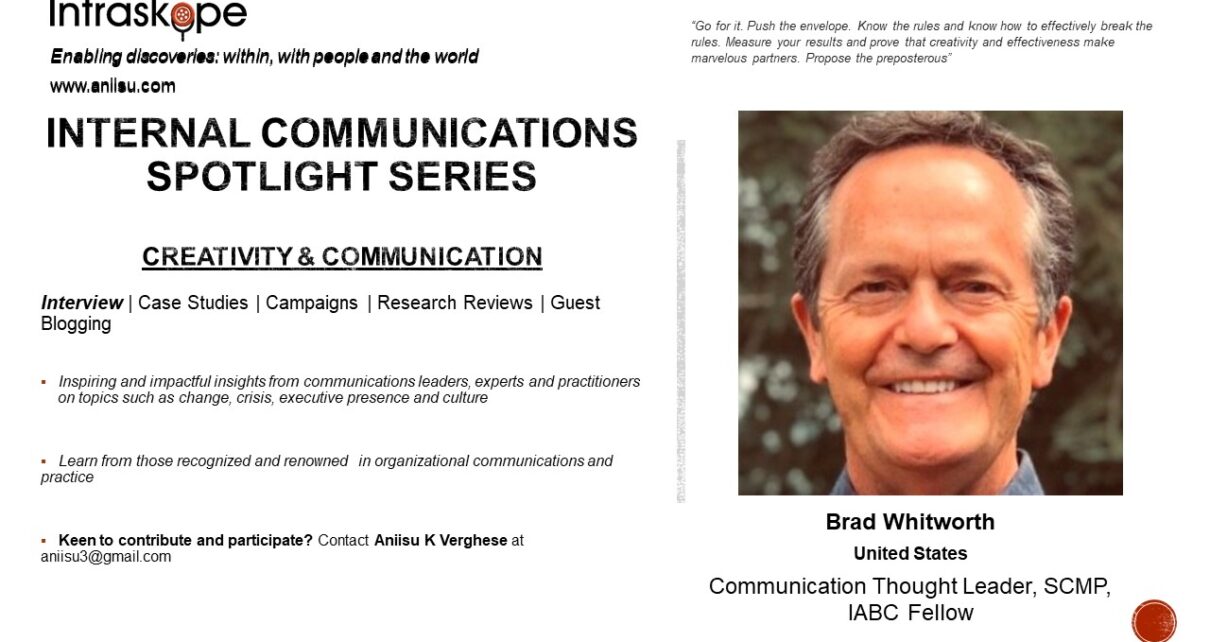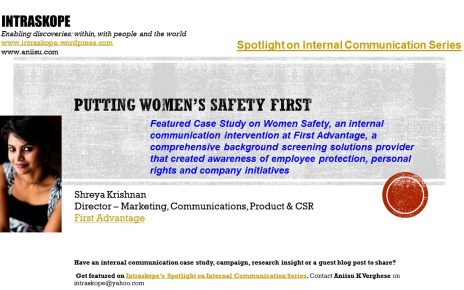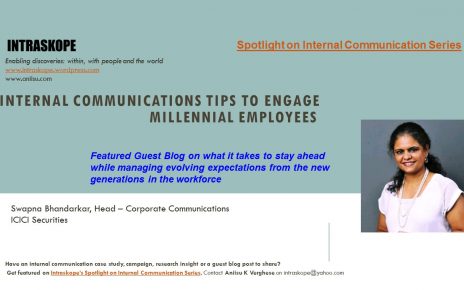Welcome to the 22nd edition of Intraskope’s Spotlight Series featuring Brad Whitworth, a senior communication and marketing executive with 40 years of experience in Fortune 20 high-tech, financial services and association management. Brad has an impressive track record with top-tier media outlets (CNN, Wall Street Journal, BBC, BusinessWeek, NY Times, Nikkei, USA Today, SJ Mercury News, Bloomberg, CBS, others). Wrote and delivered compelling US Congressional testimony. He has regularly conducted customer and VIP briefings. Also, Brad has built a virtual network of nearly 400 PR/marcom professionals and agencies across Asia Pacific, Latin America and Canada and pioneered the annual communications leadership workshop. He also contributes to elevating the profession’s stature and is a contributing author to “The IABC Handbook of Organizational Communication” (Jossey-Bass 2006).
In this interview, Brad shares his perspectives on a topic that rarely gets attention in a fast paced world of communications that we engage in – creativity. He believes we are holding ourselves back by not engaging with creative aspects in communications. We have been taught to play ‘safe’ and not taken the path less trodden and that stops us from unleashing our potential as creative communicators. He encourages communicators to step out of their comfort zones, experiment, try newer approaches and make communication sticky through creativity.
Watch this interview with Brad to learn more.
In the Spotlight on Internal Communications Series, I talk to thought leaders on topics interrelated with internal communications such as culture, crisis, change, executive presence and leadership. The goal is to help unravel why they matter, what can leaders and communicators learn from experts and how we can put insights to practice.
Interview
- What is the relevance of creativity in business communications, especially employee communications?
Creativity is what separates the memorable from the mundane. Too often we settle for the simple, the quick, the easily approved. We’ve been trained over the years to follow best practices, to not reinvent the wheel, to do what everyone else is doing.
I’ve been an evaluator on all sorts of communication awards programs. What separates the truly exceptional from the merely acceptable is that spark of creativity. It’s something that catches your attention, that makes you sit up and take notice.
Examples of creativity I have witnessed are with the Nikkei Business magazine and the Clio award winning TV commercials.
2. According to a 2015 Creativity in Internal Communications report, while 93% of professionals believe creativity is important for communications only 6% believe it has been tapped for its full potential. Why is there such a gap?
Many reasons:
- Time pressures
- Writing shorter, editing tighter. Fighting short-attention spans
- Onerous approval processes
- Complacency and willingness to settle for the ordinary
3. How do you define creativity in communications and how different is it from being innovative in communications?
They are certainly overlapping circles.
- I see Innovation focused more on processes, approaches, strategies, tools.
- I see Creativity focused more on the execution and delivery within the innovative framework.
Let me be clear … you don’t have to change everything. Sometimes it’s just the slight twist in one area that creates a piece of memorable, effective communication.
4. How can communicators develop this skill?
Seek inspiration everywhere. Clio awards, IABC Gold Quill case studies. Reading, watching, writing, getting out of your comfort zone. Go to see a show in a museum. Listen to music you don’t normally listen to. Watch a TV show or read a book that you wouldn’t usually find appealing. Get out of your comfort zone.
I think there’s also something we can learn from jazz musicians. So many jazz musicians are classically trained. Yeah, there are a few who are so gifted that they’ve never studied music seriously. But most know how to read sheet music and can do a masterful job playing a Mozart minuet or Adele’s new single. Yet they also know so much about music and its structure and its patterns that they know how to effectively break the rules in just the right ways.
5. What advice do you have for communicators to blend creativity into their everyday work?
Go for it. Push the envelope. Know the rules and know how to effectively break the rules. Measure your results and prove that creativity and effectiveness make marvelous partners. Propose the preposterous.
Also enter awards programs … which means you also have to prove your effectiveness. If you can demonstrate to your bosses and your clients that your work is effective and it’s award-winning because of its creativity, you’ll usually earn a few more degrees of freedom to try something unusual.
6. You have been at the forefront of a lot of exciting projects including IABC certifications and the recent book on business comms. Tell me more about them and what it means for communicators?
I’m firmly convinced that certification for communication professionals is going to become pervasive in the years ahead. Certification is prevalent in so many other professions … accountancy, healthcare, information technology, human resources, process management … that it’s a just a matter of time when it will be expected in the communications field.
IABC created the Global Communications Certification Council in 2015 and has been certifying hundreds of professional communicators around the world ever since. What sets the GCCC apart from any other program anywhere in the world is that we’re accredited for meeting ISO standards … that’s the International Standards Organization.
Certification is one of those signals to the rest of the world that you know the rules of the game. Think about your personal life … would you want to trust your business to a certified public accountant or someone who says he took an accounting class in college? For your next surgery, do you want to put yourself in the hands of a board-certified surgeon or someone who may know less about your procedure.
Certification is more than credentials … it demonstrates credibility and builds confidence in yourself and your work.
If you want to prep for the GCCC certification exams, one way to do so would be to review content in the brand new book from IABC – The IABC Guide for Practical Business Communication: a Global Standards Primer. In the book, you will find counsel, advice, how-to’s from some of the best and brightest in the field. 29 authors, 25 chapter on everything from technology to measurement to executive communication. My chapter is all about leading the communication function.
7. Lastly, how do you see the changes post-pandemic impacting creativity?
I am an eternal optimist, but I truly feel we will see a renaissance in our profession … a movement to unleash the potential that so many communicators have that’s been bottled up inside.
Watch the complete video interview on YouTube or read the complete transcript above.
Missed the earlier episodes? Watch them here: D. Mark Schumann (Culture), Peter Yorke (Executive Presence), Sia Papageorgiou (Leadership Communications), Dianne Chase (Strategic Storytelling), Gloria Walker (Communication Planning), Rebecca Sangster-Kelly (Stakeholder Management), Ray Walsh (Localizing Employee Communications), Prof. Matt Tidwell (Reputation), Geri Rhoades (Manager Communications), Erik K Meyers (Business Acumen), Russell-Olivia Brooklands (IC Practice Governance), Paul Barton (Public Speaking and Business Communication), Cyrus Mavalwala (Digital Communication), Elvera N Makki (Social Impact Communication), Philippe Borremans (Communication Preparedness) and Magdalena Petryniak (Influence in Communications), Priya Bates (Communicating Diversity & Inclusion), Zora Artis (Communication Alignment), Diana Bonczar (Communication Execution), Jane McConnell (Gig Mindset) and Paul Mathews (Trust & Communications).
You can also look up the ongoing Intraskope’s Spotlight on Internal Communication Series featuring practitioners from around the globe sharing best practices and perspectives.
Liked the interview? Post your comments and share it with your network.
Keen to participate in the ongoing series on Personal Branding, Crisis Communications, Internal Communications or CSR Communications? Drop me a note at [email protected]
Here are Internal Communications resources you can use:
- Learn: Internal Communications Fundamentals Course on Thinkific
- Internal Communications Series: https://forms.gle/KcqmPzLwq7NQi5Km6
- Chat with Aniisu – Internal Communications: https://www.instamojo.com/intraskope/connect-with-aniisu-60-minute-personalized-d/?ref=store
- Internal Communications workshops: https://bit.ly/2zdBRl1
You can also visit my website www.intraskope.com and You Tube channel to know more about my work.
#IC #creativity #courage #innovation #writing #focus #determination #experience #measurement #unusual #experimenting #potential #unleash #passion #ICcreativity #internalcomms #communications #internalcommunications # #covid19 #BradWhitworth #engagement #attention #attentioneconomy



